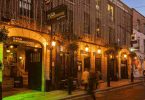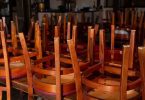Unique Australian vertical
With tastings fewer on the ground then they used to be and serious vertical tastings even rarer, it was something of a highlight of the year when Andrew Wigan, of Barossa’s Peter Lehmann estate, came to Dublin to show vintages of Stonewall Shiraz from the years 1989 to 2005. Stonewall has been a flagship wine for Lehmann since 1987 and has now solidly established its reputation as one of Australia’s most ageable wines.
The recent tasting did nothing to shift it from that position. The 2005 vintage was the only Stonewall on show which had been bottled under screw cap and Andrew Wigan is adamant that the estate won’t be going back to traditional cork. To demonstate his point, he also included, alongside the Stonewalls, four examples of the estate’s Riesling, two bottled under cork and two under screw cap.
For my own part, I felt that the rieslings under cork, from 1994 and 1997, showed more interesting development, with beautifully integrated flavours and aromas of dried lemon, honey and apricot, subtly touched with mineral elements. 1994 was a truly delicious wine with plenty of life left in it – memorable stuff. Of the screw-capped pair, 2001 showed a lacy acidity with firm green fruits, while 2003 had more decidedly lemon character and a tad more intensity to my taste. On both screw-capped bottles the typically diesel-like notes of aged riesling seemed more pronounced that in the cork bottlings, on both nose and palate, and also less integrated. The trouble is that screw capped wines are, in any case, much younger, with more primary fruit character and the various elements haven’t had time to fully bind themselves together. Only further ageing will show us the real differences between the two closure methods.
So to the Stonewall. If you ever thought Australia didn’t have vintage variation, the proof was right here, in a run of wines which went from ripe and warm, to fresh and berry-like and everything in between. Oak usage has also shifted between 1989 and 2005, with American oak predominant in the earlier years, but French oak use gradually increasing, rising to 90% by 2002. However, winemaker judgements about oak use still vary according to the needs of different vintages.
The 1989 was splendid and I think that blind tasters could well have mistaken it for a Gran Reserve Rioja. The American oak had bedded into the evolving fruit, to show sweet spices, leathery berry and plum, and wonderfully supple tannings. At peak now, it won’t be dying any time soon. 1990 had less weight and was drying a bit at the finish; yet, paradoxically, it still had noticeable primary fruit flavours and good balancing acidity. 1991 has probably peaked; but, again, there’s that hint of old Rioja and it’s very enjoyable now.
1993 is what we nowadays think of as distinctively Australian style, with fresh, clean red fruit at the end, yet rich ripeness at mid palate; perhaps not quite so long at the finish as some of the vintages but scoring on flavour and elegance. On 1998, there were some faded elements on the nose but the palate, in contrast, was surprisingly youthful, with flavours of plum, cherry and berry, and soft leathery streaks. Aromas of 1999 weren’t hugely intense, but were elegant with lively red fruits; the palate has lovely finesse, belying an alcohol level of 14%. Flavours are red berry and plum with nicely supporting tannins. For a moment it feels short – then you get a firm kick of flavour from the back palate. A wine that’s more concentrated than it feels at first mouthful, it should hold well for quite some time.
Of later vintages, 2002 has rich, almost port like fruits; it’s long although the finish feels a little dry. Those porty elements are back again in 2004 and there is some warmth of alcohol evident beneath the exuberant dark fruits; but this is tasty stuff. For 2005, screw cap has been used instead of cork. Aromas were more of spice than fruit, with soft plum and, again, dark spices on the palate and a touch of warmth to the finish. This is young wine and only time will tell whether it will develop as much generous complexity as the vintages under cork.
Lehmann wines are available from Comans (Tel; 01-4519146). Prices vary according to vintage quality and quantity, with Stonewall tending to hover around €60 retail and Reserve Riesling around €22.








